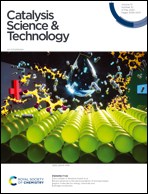Bimetallic scorpionate-based helical organoaluminum complexes for efficient carbon dioxide fixation into a variety of cyclic carbonates†‡
Abstract
A new family of bimetallic helical aluminum complexes can be obtained via warming up the preliminary dinuclear adduct complexes, or alternatively, by direct heating of the protioligands with 2 equiv. of AlR3. X-ray diffraction analysis corroborated both the high coordination versatility in the ligands and the existence of helical chirality in the complexes. DFT calculations confirmed the preferential arrangement of the ancillary scorpionates in the bimetallic complexes and rationalized the proposed reaction mechanism. Bimetallic complexes were investigated as catalysts in combination with halides for the cycloaddition reaction of CO2 with a wide range of epoxides for cyclic carbonate formation. These studies led to the development of a sustainable, inexpensive, efficient and selective bicomponent system with a very broad substrate scope, including internal and challenging bio-based trisubstituted terpene derived substrates, reaching high conversions for trans-limonene oxide under mild conditions (79% conv., 70 °C, 10 bar CO2, 1 mol%, 66 h).



 Please wait while we load your content...
Please wait while we load your content...